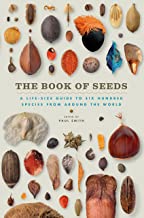 The Book of Seeds presents seed profiles of 600 different species of plants in order to show the great diversity that exists among seeds. The seeds were chosen on the basis of unique shape, size, or color, geographic distribution, human use, scientific significance, unusual natural history, and endangered status. The species are arranged by phyla into 5 groups each of which is further arranged by family, subfamily, genus and species. A full page is devoted to each kind of seed and includes a a color photo of the seed, life size and in detail, with an engraving of a plant that produced them, a distribution map, a table of essential information such as habitat and conservation status, and a commentary of notable characteristics such as appearance of the plant, taxonomic importance, and related species.
The Book of Seeds presents seed profiles of 600 different species of plants in order to show the great diversity that exists among seeds. The seeds were chosen on the basis of unique shape, size, or color, geographic distribution, human use, scientific significance, unusual natural history, and endangered status. The species are arranged by phyla into 5 groups each of which is further arranged by family, subfamily, genus and species. A full page is devoted to each kind of seed and includes a a color photo of the seed, life size and in detail, with an engraving of a plant that produced them, a distribution map, a table of essential information such as habitat and conservation status, and a commentary of notable characteristics such as appearance of the plant, taxonomic importance, and related species.
The book is visually very attractive and the up-close look at the seeds is fascinating to those of us interested in plant morphology or just seeds. The information about each seed and related plant is well chosen to capture attention and stir the imagination. We learn for example that sea grape has an active ingredient that is a performance-boosting substance, early settlers used greenbriar to make root beer, and that the larvae of the moths that pollinate the flowers of the Joshua tree feed on the seeds until the Joshua tree selectively aborts enough of the seeds to maintain the balance between seeds and moths. The Book of Seeds is not a definitive book on seeds or highly scientific in content and as the subtitle says, it is “a life-size guide to six hundred species from around the world” . As a result it does use any scientific jargon and can be enjoyed by the any reader that likes plants and seeds.
To buy The Book of Seeds from Amazon.com click here.